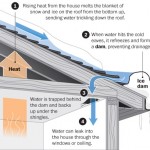Home Inspector: 4 Quick Fixes for Ice Dams
It’s a winter wonderland out there! With a fresh coating of snow arriving almost daily, we ask ourselves will it ever stop?
Of course, we know it will but not without a little more pain, in the form of the dreaded ice dam on our homes.
An ice dam forms at the edge of the roof when melting snow from the roof re-freezes at the colder roof edge. Icicles form along with a large block of ice, usually starting in the gutter channel. As this block of ice continues to grow, the snow melt from the roof has no where to go as it flows down your roof. Hence the ice becomes a dam.
Consequently, the snow melt now starts to back up under roof shingles and potentially infiltrate to the interior of the home.
Permanent Fix
The formation of an ice dam can be prevented by providing for proper ventilation and insulation of the attic space in your home.
Ideally, the roof area should be kept as cold as possible during the winter months. This is best accomplished by providing optimal ventilation of the space to allow any heat to escape the attic before it has a chance to heat the roof and melt the snow.
Secondly, the floor of the attic should be insulated and sealed to minimize heat loss from the living spaces, thereby reducing the opportunity for heat accumulation in this space.
Following these two steps will go a long way in reducing the opportunity for ice dam formation at your home. However, it may not be enough. During some of the most severe winters, ice dams may continue to form despite all your best efforts to guard against them. With that in mind, a second line of defense would be most desirable.
Installation of a snow and ice shield, under the shingles, at the roof’s edge is highly recommended. This ice shield is typically laid 6 feet up from the roof’s edge and is comprised of a rubber membrane like material. It has self-sealing properties so that when a nail penetrates it, a seal is formed around the nail to prevent water from leaking through and into your home.
Quick Fixes
If an ice dam has already formed, your options become more limited but nonetheless more critical because you want to prevent or stop water from coming into your home. Here are a few quick fixes, keep in mind if it involves using a ladder or accessing the roof area you should hire a professional.
- Use a roof rake to remove snow from the lower portion of the roof. You can do this from the ground on most single storey homes. You only need to remove the lower portion of snow although, if you remove all the snow from the roof, your efforts may be more effective. You do not need to clean the roof to the bare shingle.
- Install heater tapes at the roof edges and in the gutter channels. This method works best when installed prior to the ice formation and they should be turned on prior to the ice forming.
- Fill an old pair of pantyhose with calcium chloride ice melt and place it vertically on the roof edge and across the ice dam. In so doing, it will melt the ice and form a channel allowing snow melt to drain off the roof’s edge.
- Using warm water, take a garden hose and spray the ice thereby melting the dam and forming a channel to allow water to drain. This method provides limited effectiveness of just a day or two.
Not Recommended
There are a few methods out there that we do not recommend due to risk of damage to your property as well as physical injury. They usually include using a mechanical device such as an ice pick, chisel or other tools to try and break up the ice.
__________________________________________________________
Lawrence Watkins is a NYS Licensed Home Inspector and the President of Specsure Property Inspections. As a leading full service residential home inspection and commercial property inspection company proudly serving Buffalo, Lewiston, Orchard Park and all of Western New York (WNY) for over 20 years, we are pleased to provide timely and simple DIY tips and hints for today’s homeowner.
For more information you can reach us at 716-881-1914 or via email at info@specsure.com.



